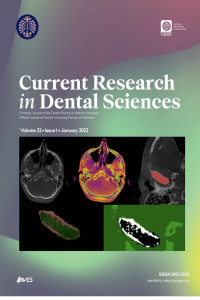FARKLI DEZENFEKSİYON YÖNTEMLERİNİN CAD / CAM VE KONVANSİYONEL AKRİLİK REZİNLERİN YÜZEY SERTLİĞİNE ETKİSİ
Akrilik rezin, Dezenfektan solüsyon, Dezenfeksiyon, CAD/CAM akrilik
___
- 1. ADA Council on Scientific Affairs and ADA Council on Dental Practice: Infection control recommendations for the dental office and the dental laboratory. J Am Dent Assoc 1996;127:672-80.
- 2. Vafaee F, Radan P, Firouz F, et al: Microbial contamination of pumice powder and slurry in dental laboratories of Hamadan. Avi J Dent Res 2013;5:e19377.
- 3. Savabi O, Attar K, Nejatidanesh F, Goroohi H, Badrian H. Effect of different chemical disinfectants on the flexural strength of heat-polymerized acrylic resins. Eur J Prosthodont Restor Dent 2013;21:105-8.
- 4. Vasconcelos LR, Consani RLX, Mesquita MF, Sinhoreti MAC. Effect of chemical and microwave disinfection on the surface microhardness of acrylic resin denture teeth. J Prosthodont 2013;22:298–303.
- 5. Pawashe KG, Tewary S, Sanyal PK, Nilesh K. An In vitro Comparative Evaluation of Disinfectants on Standard and Clinical Microbial Strains on Heat Cure Resins. J Clin Diagn Res 2017;11:ZC54-ZC58
- 6. Muscat Y, Farrugia C, Camilleri L, Arias‐Moliz MT, Valdramidis V, Camilleri J. Investigation of acrylic resin disinfection using chemicals and ultrasound. J Prosthodont 2018;27:461-468.
- 7. Harrison Z, Johnson A, Douglas WI. An in vitro study into the effect of a limited range of denture cleaners on surface roughness and removal of Candida albicans from conventional heat-cured acrylic resin denture base material. J Oral Rehabil 2004;31:460–67.
- 8. Iseri U, Uludamar A, Ozkan YA. Effectiveness of different cleaning agents on the adherence of Candida albicans to acrylic denture base resin. Gerodontology 2011;28:271–76.
- 9. Silva MM, Vergani CE, Giampaolo ET, Neppelenbroek KH, Spolidorio DM, Machado AL, et al. Effectiveness of microwave irradiation on the disinfection of complete dentures. Int J Prosthodont 2006;19:288–93.
- 10. Gandhi N, Daniel S, Benjamin S, Kurian N, Varghese VS. Evaluation of surface microhardness following chemical and microwave disinfection of commercially available acrylic resin denture teeth. J Clin Diagn Res 2017;1:ZC87-ZC91
- 11. Çetindağ MT, Meşe A. Diş hekimliğinde kullanılan CAD/CAM (Bilgisayar Destekli Tasarım/Bilgisayar Destekli Üretim) sistemleri ve materyaller. J Dent Fac Atatürk Uni 2016;26:524-33.
- 12. Ayman AD. The residual monomer content and mechanical properties of CAD\CAM resins used in the fabrication of complete dentures as compared to heat cured resins. Electronic physician 2017l;9:4766.
- 13. Srinivasan M, Gjengedal H, Cattani-Lorente M, Moussa M, Durual S, Schimmel M, Müller F. CAD/CAM milled complete removable dental prostheses: An in vitro evaluation of biocompatibility, mechanical properties, and surface roughness. Dent Mater J 2018;37:526-533.
- 14. Al‐Dwairi ZN, Tahboub KY, Baba NZ, Goodacre CJ. A Comparison of the Flexural and Impact Strengths and Flexural Modulus of CAD/CAM and Conventional Heat‐Cured Polymethyl Methacrylate (PMMA). J Prosthodont 2018 Jun 13. doi: 10.1111/jopr.12926.
- 15. Anusavice KJ, Phillips RW. Phillip’s science of dental materials. 11th ed. St Louis: Elsevier; 2003. p. 33-47.
- 16. Orsi IA, Junior AG, Villabona CA, Fernandes FH, Ito IY. Evaluation of the efficacy of chemical disinfectants for disinfection of heat‐polymerised acrylic resin. Gerodontology 2011;28:253-7.
- 17. Consani RL, Mesquita MF, de Arruda Nobilo MA, Henriques GE. Influence of simulated microwave disinfection on complete denture base adaptation using different flask closure methods. J Prosthet Dent 2007;97:173-8.
- 18. Neppelenbroek KH, Pavarina AC, Vergani CE, Giampaolo ET. Hardness of heat-polymerized acrylic resins after disinfection and long-term water immersion. J Prosthet Dent 2005;93:171-6.
- 19. Hamanaka I, Iwamoto M, Lassila LV, Vallittu PK, Takahashi Y. Wear resistance of injection-molded thermoplastic denture base resins. Acta Biomater Odontol Scand 2016;2:31-37
- 20. Suwannaroop P, Chaijareenont P, Koottathape N, et al. In vitro wear resistance, hardness and elastic modulus of artificial denture teeth. Dent Mater J 2011;30:461–468.
- 21. Jaiswal P, Pande N, Banerjee R, Radke U. Effect of repeated microwave disinfection on the surface hardness of a heat-cured denture base resin: An In vitro study. Contemp Clin Dent 2018;9:446-451.
- 22. Mahmood MA, Khalaf BS, Abass SM. Efficiency of Different Denture Disinfection Methods. Global J Bio-sci Biotech 2017;6:439-4.
- 23. Azevedo A, Machado AL, Vergani CE, Giampaolo ET, Pavarina AC, Magnani R. Effect of disinfectants on the hardness and roughness of reline acrylic resins. J Prosthodont 2006;15:235-42.
- Başlangıç: 1986
- Yayıncı: Atatürk Üniversitesi
ÇOCUK HASTALARDA ODONTOMALARIN DEĞERLENDİRİLMESİ: RETROSPEKTİF-KESİTSEL BİR ÇALIŞMA
Derya CEYHAN, Canan AKDİK, Zuhal KIRZIOĞLU
Yasemin SEZGİN, Mediha Nur NİŞANCI YILMAZ
Kübra CANTÜRK, Buket KARALAR, Ömer SAĞSÖZ, Nilgün SEVEN, Nurdan POLAT SAĞSÖZ, Yusuf ZİYA BAYINDIR
Hatice AĞAN, Ayhan GÜRBÜZ, Rukiye DURKAN, Gdnca DESTE
SONLU ELEMANLAR STRES ANALİZİ YÖNTEMİNİN İMPLANT CERRAHİSİNDE KULLANIMI
AİLELERİN FLORÜRLÜ AĞIZ BAKIM ÜRÜNLERİNE BAKIŞ AÇILARININ VE DAVRANIŞLARININ DEĞERLENDİRİLMESİ
Banu ÖTER, Barış KARABULUT, Günseli GÜVEN POLAT, Sevi Burçak ÇEHRELİ
TEMPOROMANDİBULAR EKLEM HASTALIKLARINDA MEDENİ HAL DURUMU
Muhammed Enes NARALAN, Binali ÇAKUR
Ertan YALÇIN, Hakan USLU, Ertunç DAYI
ZİRKONYA DENTAL İMPLANTLAR: KLİNİK PARAMETRELER, YAPISAL ÖZELLİKLER, GÜNCEL SİSTEMLER
Gonca DESTE, Rukiye DURKAN, Perihan OYAR
ÇENELERİN BENİNG FİBROOSSEÖZ LEZYONLARININ KONİK IŞINLI BİLGİSAYARLI TOMOGRAFİ ile DEĞERLENDİRİLMESİ
